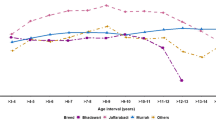Abstract
The Garole is a prolific but less well known and rare breed of small sheep found in the hot and humid Sunderban region of West Bengal. An ability to breed throughout the year and to graze in knee-deep water, resistance to foot rot and a strong mothering instinct are some of the special features of this breed. Garole rams could provide germplasm to incorporate prolificacy traits by artificial insemination of the nonprolific sheep breeds found in abundance in the semi-arid and arid tropical climates of India. The aim of the present study was to evaluate the semen production by Garole rams maintained in a semi-arid climate for three years and to objectively assess their semen quality by a computer-assisted sperm analysis technique. The donor rams were randomly selected each year from the original flock procured from their natural habitat or from the offspring born at the Institute farm. Semen was collected weekly for three weeks each autumn for three consecutive years from 8 rams each year. The overall means (SD) of the traits that did not differ significantly with age or year were volume, concentration, curvilinear velocity, average path velocity, amplitude of lateral head displacement, beat frequency, motility and the percentages of rapid motile sperms and of slow motile sperms. The age of the rams had a significant effect (p<0.05) on the straight-line velocity but this was not significantly affected by the length of exposure to the semi-arid climate. However, the age and year had significant effects (p<0.05) on linearity, straightness and the percentage of medium motile sperms. It was concluded that Garole rams are capable of producing good-quality semen even after a prolonged period of exposure to a semi-arid tropical climate.
Similar content being viewed by others
REFERENCES
Aitken, R.J., 1990. Motility parameters and fertility. In: C. Gagnon (ed.), Controls of Sperm Motility: Biological and Clinical Aspects, (CRC Press, Boca Raton), 285-302
Bose, S. and Moitra, D.N., 1995. Bengal breed of sheep in the Sunderbans. Asian Livestock, 20, 16-17
Chemineau, P., Cagnie, Y., Guerin, Y., Orgeur, P. and Vallet, J.C., 1991. In: Training Manual on Artificial Insemination in Sheep and Goats, (FAO Animal Production and Health Paper 83, Rome), 115-161
Davis, R.O. and Katz, D.F., 1992. Standardization and comparability of CASA instruments. Journal of Andrology, 13, 81-85
Davis, R.O. and Katz, D.F., 1993. Operational standards for CASA instruments. Journal of Andrology, 14, 385-394
Davis, R.O. and Siemers, R.J., 1995. Derivation and reliability of kinematic measures of sperm motion. Reproduction Fertility and Development, 7, 857-869
Evans, G. and Maxwell, W.M.C., 1987. Handling and examination of semen. In: Salamon's Artificial Insemination of Sheep and Goats, (Butterworths, Sydney), 93-106
Fahmy, M.H. and Mason, I.L., 1996. Less known and rare breeds. In: M.H. Fahmy (ed.), Prolific Sheep, (CAB International, Wallingford), 178-186
Ghalsasi, P.M. and Nimbkar, B.F., 1993. The “Garole” microsheep of Bengal, India. Animal Genetic Resource Information, 12, 73-79
Harvey, W.R., 1990. Mixed model least squares and maximum likelihood computer programme, PC-2 version. In: User's Guide for LSMLMW, (Ohio State University, Columbus)
Holt, W.V. and Palomo, M.J., 1996. Optimization of a continuous real-time computerized semen analysis system for ram sperm motility assessment and evaluation of four methods of semen preparation. Reproduction Fertility and Development, 8, 219-230
Joshi, A. and Mathur, A.K., 1996. Assessment of sperm kinematics of frozen-thawed ram spermatozoa. Indian Journal of Animal Reproduction, 17, 42-44
Joshi, A., Bag, S. and Mittal, J.P., 1999a. Assessment of semen characteristics of Garole rams. International Journal of Animal Science, 14, 277-279
Joshi, A., Bag, S. and Mittal, J.P., 1999b. Computer-assisted sperm analysis of freshly diluted and stored Garole ram liquid semen. Indian Journal of Animal Sciences, 69, 19-20
Kramer, C.Y., 1956. Extension of multiple range test to group means with unequal numbers of replicates. Biometrics, 12, 307-310
Maurya, V.P., Mittal, J.P., Naqvi, S.M.K. and Joshi, A., 1999. Dominance, libido and serving capacity of Garole rams under semi-arid region of Rajasthan. Indian Journal of Animal Sciences, 69, 773-775
Sharma, R.C., Arora, A.L., Narula, H.K. and Singh, R.N., 1999. Characteristics of Garole sheep in India. Animal Genetic Resource Information, 26, 57-64
Singh, R.N. and Bohra, S.D.J., 1996. Garole sheep a profile (Bengal breed of sheep, locally known as Garole). Indian Journal of Small Ruminants, 2, 38-42
Turner, H.N., 1982. Origins of the CSIRO Booroola. In: L.R. Piper, B.M. Bindon and R.D. Nethery (eds), The Booroola Merino, (CSIRO, Australia), 1-7
Author information
Authors and Affiliations
Rights and permissions
About this article
Cite this article
Joshi, A., Naqvi, S., Bag, S. et al. Sperm Motion Characteristics of Garole Rams Raised for a Prolonged Period in a Semi-arid Tropical Environment. Tropical Animal Health and Production 35, 249–257 (2003). https://doi.org/10.1023/A:1023347514476
Issue Date:
DOI: https://doi.org/10.1023/A:1023347514476




